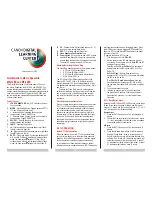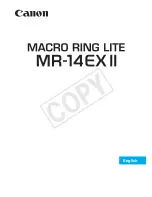
Zorki-4K Brief Description
– 6 –
In the centre of the viewfinder field of view there can be seen
a yellowish rectangle with a double image of the object being
viewed in it. Turn the lens focusing ring to match the two
images of the same object. Keep in mind that the image should
be focused in the centre of the yellowish field.
The image can be focused by the lens distance scale
calibrated in metres as well. In such a case the distance to the
object being photographed should be known beforehand.
The viewfinder enables to see the limits of picture.
For correct framing bring your eye as close to the eyepiece
as possible; in so doing the yellowish rectangle should be
placed in the centre of the view-finder field of view. If the
above rules are not followed, framing is likely to be wrong i. e.
the limits of image seen in the viewfinder would fail to
correspond to the frame limits on the negative.
To take a picture of several objects placed at different
distances from the camera, use should be made of a depth-of-
field scale. The scale consists of the aperture numbers repeated
on both sides of the main index mark. When the aperture is set
and the lens is focused, the limits of depth of field can be read
against these number pairs on the distance scale.
For example, with the lens focused for 3 m and aperture of
f/8, two figures 2.2 m and 4.8 m on the distance scale will be set
against divisions 8 of the depth-of-field scale.
These distances are called the near and far limits of depth of
field. Objects placed nearer than 2.2 m or farther than 4.8 m, will
be blurred in the picture. The far limit of the depth of field may
coincide with the infinity mark “∞” or even come beyond the
distance scale. In such a case all the objects placed between the
near limit of depth of field and infinity will be sharp on film.
It should be kept in mind that the larger the aperture, the smaller is the depth of field and vice versa.
5.5. Photographing
To take a picture do the following:
a) load the camera;
b) take the cap off the lens;
c) set the lens aperture (if required put a light filter or a sun
shade on the lens);
d) set the shutter;
e) set a required shutter speed;
f) watching through the eyepiece of the range-view-finder,
point the camera at the object, adjust the eyepiece according to
your eye and focus the lens;
g) smoothly press the shutter release button.
NOTE. When using shutter speeds slower than 1/30 s it is
recommended to mount the camera on a tripod and to screw a
cable release into of the release button bush.
5.6. Camera Unloading
When the exposure counter shows figure 36 rewind the film into the cassette. For this aim:
a) remove the case;
b) turn the shutter disengaging bush in the clockwise direction as far as it will go;
c) pull the film rewind knob upwards and rotate it in the arrow direction till the feel of the applied
force indicates that the film end has left the take-up spool;


























